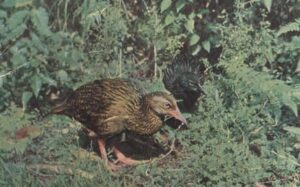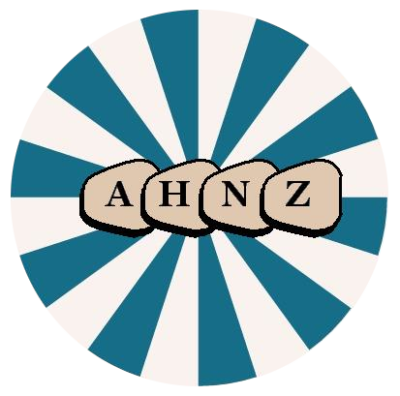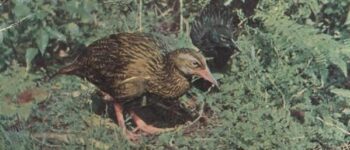1903: Canterbury Weka Wiped Out
May 6, 2025
By AHNZ

Amusing to see that a woodhen managed to hop a ride coast to coast. From an Inangahua campsite on the West Coast it jumped into the vehicle of some campers who discovered the bird when they returned to Christchurch. No weka, aka New Zealand hen, aka Maori hen have been in the wild in Canterbury for about 120 years. They were once as plentiful as they now are on the West Coast.
The bird is back home now after some somewhat bizarre fuss. The Ranger couple picked it up in their Ford Ranger which led to the animal being named ‘Ranger’….
“Ranger was collected by DOC and checked over at the South Island Wildlife Hospital where — apart from being slightly dehydrated — was in good health and was released back to the area from where it hitched a ride. DOC Biodiversity supervisor Craig Alexander said the episode was a reminder for people to check their vehicles for any wildlife when camping. “There are no wild weka in Christchurch so we wouldn’t want to see them accidentally introduced here.”” – 1News (5/May/2025)
If the Canterbury Settlers were to learn of such bother they’d be scratching their heads. Phone calls, administration, health checks, and then chauffeur driven back home by the government! Back to the West Coast where weka are flattened on the highways so frequently that nobody thinks anything of it. The ones that don’t get hit seem to have developed a high-speed power mode where they lower their center of gravity and charge from cover to cover before a car can send them to weka Valhalla.
Ranger’s back to doing that again at great trouble and expense. He’s been in the paper, on TV, on the radio and so it wouldn’t have done for DOC to simply hit him with a car in Christchurch. Got to let that happen in his natural environment! Barmy…
The demise of the Canterbury weka happened in about 1903 according to first hand knowledge of Charles Overton who knew them as a boy. Born in 1881, he grew up on a farm in the Eyre Country beyond the Waimakariri River. Predatory species had been introduced (again) to put the invading Otago rabbits in check in the 1890s and these made it to his part of Canterbury and ended the weka population which must have made Canterbury their home for hundreds of years…
“I had my first gun when I was twelve…About that time, Californian quail began to show up in the riverbed, and numerous wood-hens or weka could be heard giving their shrill cry—usually before rain. I have seen a weka hen with ten or twelve little chicks following her on more than one occasion among the gorse bushes. As soon as the stoats and weasels were liberated in the 1890s, these birds began to disappear. By the end of the century—around 1900 to 1903—they had been completely wiped out.” – Fifty years sheep farming in Canterbury, Otago and Southland, Overton (1959)
“The 1889 annual report to the Rabbit Nuisance Committee includes a statement from R. Foster, the district sheep inspector based in Christchurch, that a total of 600 stoats and weasels were liberated in the district during the year…‘The little things seemed none the worse for their journey, but ran away and disappeared at once among the rocks – going for the rabbits and wekas minutes afterwards’.” – Carolyn M. King, Zealand Journal of Ecology (2017)
The government, influenced by opinions of the time that predators were the best way to control rabbits, decided to import and liberate stoats and weasels, seeing them as “the natural enemy” of the rabbit. The Government’s Chief Rabbit Inspector placed all natural enemies of the rabbits, including stoats and weasels, under legal protection.
Thus, The Government, as per usual, is responsible for destroying a unique species population: The Canterbury Weka.
—
Image ref. Riverton Museum (1959,) Ehive
 Like Comment Share
Like Comment Share





